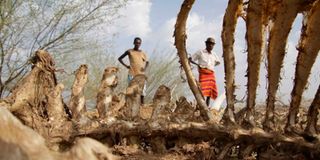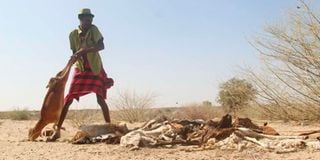Drought visits death and misery upon residents in the arid north

Locals view a livestock carcass in Sieslucho village in Marsabit County on April 2. The prolonged drought in the area has led to heavy losses for the community that relies on livestock for survival.
The gates of hell are wide open in the northern parts of the country, where there’s a very thin line between living and surviving.
From biting poverty, acute hunger and unforgiving weather conditions to blood-thirsty bandits, everything that could possibly go wrong has gone wrong in the drought-stricken region.
Despair hangs on the faces of locals and the hope of getting any form of relief is as bleak as the scorched sandy and rocky grounds they call home. The bleating of goats and sheep and mooing of cows characteristic of this region’s ambience have been muted under the scorching sun.
For a region inhabited predominantly by nomadic pastoralists, sightings of herders traversing the dry lands in search of pasture is rare. There’s nothing to herd and worse, there is neither pasture nor water.

A herder dumps a dead goat onto a pile of carcasses in Illeret, Marsabit County. The devastating drought in Northern Kenya has left pastoralist communities without pasture leading to death of hundreds of thousands of livestock.
Most of their livestock have died due to drought, leaving them without a source of livelihood.
About 12 children have reportedly died of hunger in Illeret Ward in Marsabit County. However, these numbers could be higher as most deaths are never reported to authorities.
The lack of reporting is due to a tradition among the Daasanach people, where speaking of the dead is considered a taboo, especially of children.
Starvation
“About 12 children have died of starvation and other complications caused by malnutrition. There could be more especially in far-flung villages. Among the Daasanach, people do not speak of the dead. It is not just children, the elderly are also dying,” says Mr Stephen Kute, a community health volunteer.
In Harre village along the Kenya -Ethiopia border, Jane (not her real name) stares at the horizon from her new manyatta, as though looking for answers. She recently lost her baby to starvation and as tradition dictates, she has to move into a new home.
“We have not been getting much food and I could not feed my baby. There is no food,” she says. Like everyone else in the village, Jane has been living off scraps from local hotels on the Ethiopian side of the border. On a good day, she gets fish bones on the shores of Lake Turkana once fishmongers are done filleting.
“We boil the bones and drink the soup. Sometimes there is some leftover flesh on the bones. We share the soup with neighbours,” she says. About 17 kilometres south in Sieslucho village, three women are yet to come to terms with the deaths of their children. It is even more painful that two of them could not bury them.

A herder stands over a carcass at Horri Guda in North Horr, Marsabit County. After grappling with livestock losses in the hundreds of thousands caused by lack of rains for two consecutive years, two days of heavy rains claimed nearly all of the remaining herds.
Ms Elele Lomortony and Ms Gushumo Elasho took their children to hospital on the Ethiopian side two months ago before they died of hunger. Ms Galvi Kerich, who is visually impaired, is mourning the loss of her grandson and fears she will be next as all food has run out.
“I could not feed him and he died. Now I cannot feed myself; I survive on water only,” she says.
In Kerich village in Illeret, Mr Janle Herogalie has lost over 200 livestock to drought and has now been reduced to a beggar. His wife left home to earn a living across the border. Their two children also left. His elderly and frail body cannot allow him to work or look for food. His chances of survival are diminishing by the day.
2.8 million Kenyans
“It pains me that this may just be the beginning of my death and the entire generation,” says Mr Herogalie. Former Ileret chief Siyel Oita called on well-wishers to come to their rescue. He said the Herogalie family’s predicament was one faced by all the households in the ward.
According to the National Drought Management Authority, at least 2.8 million Kenyans are faced with starvation. Despite acknowledging the dire situation in the north, the government has been criticised for inaction.
President Kenyatta has declared drought a national disaster and commissioned relief programmes, including the allocation of Sh2 billion and release of food for 2.3 million households.
However, the starving communities are yet to receive any form of aid, and for those that have, it is barely enough to keep them alive. Marsabit County Commissioner Paul Rotich last week flagged off consignments of relief food to cushion vulnerable families from drought. Only about 32,000 families across the county are set to benefit from relief food supplies. Mr Rotich said each beneficiary will receive 10 kilos of rice, seven of beans and fortified wheat.
“There has been no form of government aid. The people of Illeret have been abandoned. We have failed our children by just watching them starve to death,” said Mr Peter Alkol, a resident.






